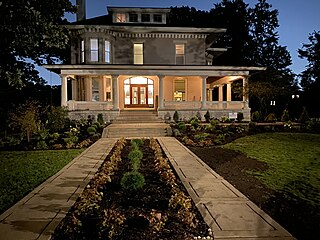
The William H. Copeland House is a home located in the Chicago suburb of Oak Park, Illinois, United States. In 1909 the home underwent a remodeling designed by famous American architect Frank Lloyd Wright. The original Italianate home was built in the 1870s. Dr. William H. Copeland commissioned Wright for the remodel and Wright's original vision of the project proposed a three-story Prairie house. That version was rejected and the result was the more subdued, less severely Prairie, William H. Copeland House. On the exterior the most significant alteration by Wright was the addition of a low-pitched hip roof. The house has been listed as a contributing property to a U.S. Registered Historic District since 1973.
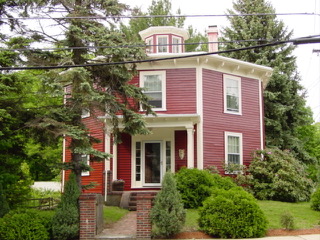
The William Bryant Octagon House is an historic octagon house located at 2 Spring Street in Stoneham, Massachusetts. Built in 1850, it is the best-preserved of three such houses built in the town in the 1850s. It was listed on the National Register of Historic Places in 1984.

The Wendell Bancroft House is a historic house in Reading, Massachusetts. Built in the late 1860s, it is one of the town's few surviving examples of residential Gothic Revival architecture, built for one of its leading businessmen of the period. The house was listed on the National Register of Historic Places in 1984.

The A. W. Patterson House is a historic house in Muskogee, Oklahoma. Located at the intersection of 14th Street and West Okmulgee, it is situated at the crest of a hill near the western edge of the downtown Muskogee neighborhood. It was built in 1906, before Oklahoma achieved statehood in 1907. It was listed on the National Register of Historic Places in 1984.
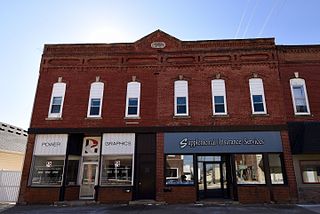
The New Era Building, also known as the Dobson Town Clock Building, is a commercial building located in Maquoketa, Iowa. The Late Victorian structure was designed by John Lake and built in 1890. The building was owned by Dr. A.B. Dobson, a "clairvoyant physician who treated patients by mail." Patients were asked to send one dollar and a lock of hair, which would enable him to cure their ills. The building's clock tower was built separately and was removed for scrap to help in the war effort during World War II.
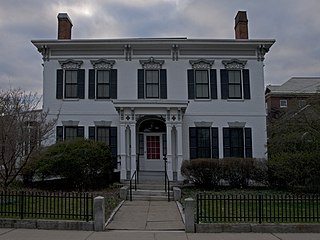
The President's House of Keene State College, formerly the Catherine Fiske Seminary For Young Ladies, is a historic house at 251 Main Street in Keene, New Hampshire. Built in 1805 and restyled in the late 19th century, it is one of Keene's oldest brick residences, and now serves as the official residence of its president. The house was listed on the National Register of Historic Places in 1976.
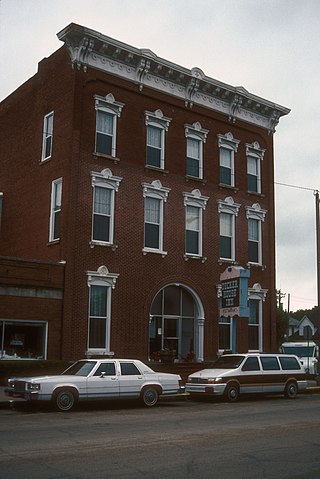
The Decker House Hotel is a historic building located in Maquoketa, Iowa, United States. James Decker, an entrepreneur from Watertown, New York held numerous real estate holdings in and around Maquoketa. He built the first Decker House, a frame structure, in 1856. After Maquoketa was named the county seat in 1873, Decker decided to replace it. The three-story, brick, Italianate building was designed by Watertown architect W.W. Tucker. Its decoration is limited to the north and east elevations. Noteworthy, is its metal cornice and window hoods. It opened in May 1878, and it had two other competitors in town at that time. Following his death in 1881, James Decker's son Leonard took over his holdings in New York and Iowa. He moved into the Decker House in 1885 and died there in 1900. The building has subsequently lost its entrance porch, original front doors and the pediment over the cornice. It was listed on the National Register of Historic Places in 1978.

The D.H. Anderson House is a historic house located at 315 East Locust in Maquoketa, Iowa.

The George Cooper House is a historic residence located in Maquoketa, Iowa, United States. This is one of several Victorian houses in town that are noteworthy for their quoined corners, a rare architectural feature in Iowa. The two-story brick house features decorative gable ends, inset porches, bay window, and a gambrel dormer. It was built in 1884, which were known as financial boom years for Maquoketa. The house is located in a neighborhood with other late 19th and early 20th century houses. It was listed on the National Register of Historic Places in 1991.

The A.A. Hurst House is a historic residence located in Maquoketa, Iowa, United States. This house shows the strongest influences of the Prairie School style in town. It was built on the site of a previous house at a time when newer and larger houses were replacing Maquoketa's older buildings. It was designed by Davenport architect E.G. Holbrook. The two-story house features a low pitched hip roof, broad eaves, paired windows, banded windows in groups, a stuccoed exterior, and a broad porch. Abe A. Hurst was the son of Alfred Hurst, who founded the A. Hurst and Company Lime Works and the company town of Hurstville. In addition to the family business, they were also involved with Maquoketa Electric Light and Power Company. This connection allowed Abe to be involved with the construction of Lakehurst, a hydro dam and power plant, in 1923. The house was listed on the National Register of Historic Places in 1991.

The Mrs. Lydia Johnson House is a historic residence located in Maquoketa, Iowa, United States. This house is a fine example of Queen Anne style architecture in the United States. It was built during the economic boom years in the city's development. Built in 1895, the two and one half storey house features a complex irregular composition, a corner tower, wrap-around porch, a small porch on the second floor above the main porch, various window shapes and sizes, and textured wall surfaces on the exterior. Little is known about the Johnson family who built it, but its notability is derived from the architecture. The house was listed on the National Register of Historic Places in 1991.

The John Lake House is a historic residence located in Maquoketa, Iowa, United States. This is one of several Victorian houses in Maquoketa that are noteworthy for their quoined corners, a rare architectural feature in Iowa. Built around 1890, the 1½-story house features limestone quoins, a gable roof, gambrel dormers on the north and east elevations, a polygonal bay under the east dormer, two small porches, and a gabled wing on the west side. A unique feature on this house are the glazed colored tiles on the main facade. John Lake was a local builder, who is associated with the construction of the New Era Building and the IOOF Building. It is possible he built this house as well, although the builder has not been determined. The house was listed on the National Register of Historic Places in 1991.

The Alexander Organ House is a historic residence located in Maquoketa, Iowa, United States. It is one of several Victorian houses in Maquoketa that are noteworthy for their quoined corners, a rare architectural feature in Iowa. Built around 1896, the 21⁄2-story brick house follows an L-shaped plan. It features a 11⁄2-story wing in the back, quoining with cream-colored brick, limestone foundation, gable roof, a polygonal bay window on the east elevation, and a bracketed canopied porch with cresting on the main facade. Organ worked as a clothing merchant. This house was one of many houses built during Maquoketa's economic expansion in the late 19th century. It was listed on the National Register of Historic Places in 1991.

The J.E. Squiers House, also known as the Squiers Manor Bed and Breakfast, is a historic building located in Maquoketa, Iowa, United States. The architectural and historic significance of this house is attributed to its being "a well-preserved example of late nineteenth century domestic architecture in Maquoketa's most prominent residential neighborhood and for its association with the life and career of James Emery Squiers, a prominent local businessman." Built in 1882, the 21⁄2-story brick house features elements consistent with the Queen Anne and Stick styles. It follows a central hall floor plan with two rectangular projecting bays, a three-sided bay window, a kitchen addition on the back, and a hipped roof with intersecting gable sections.

The Bassnett–Nickerson House is a historic house located at 116 South Vermont in Maquoketa, Iowa.

The Perham House is a historic residence located in Maquoketa, Iowa, United States. This is one of five Greek Revival houses in Maquoketa that represent its earliest extant houses built during its early growth period. Built about 1859, the two-story frame house features a gable roof, full entablature creating a triangular pediment, pilastered corners, and a small wing on the west side. Russell Perham was a New York native who settled in Maquoketa in 1858, and bought this property a year later. It is not known if he had the house built or not. However, the Perham family did own it until Charlotte, his widow, sold the house in 1908. Russell Perham was engaged in the mercantile and milling business, and served as the Justice of the Peace. The house was listed on the National Register of Historic Places in 1991.

The Allen House is a historic building located in Dyersville, Iowa, United States. T.F. Allen was a land speculator and developer who had this house built in 1857, which was the peak year for building in Dyersville. That year the town was the terminus of the Dubuque and Pacific Railway. Thirty houses were built in the town that year, and others were under contract. Within a year, the railroad had expanded further west, and the town was in an economic depression exacerbated by the Panic of 1857. There is no mention of Allen or his family in Dyersville in the 1860 United States census.

The Isham-Terry House is a historic house museum at 211 High Street in Hartford, Connecticut. Built around 1854, from 1896 it was home to members of the Isham family, who restored it in the early 20th century. The family donated the property to Connecticut Landmarks in the 1970s, which now operates it has a museum, offering guided tours and facility event rentals. The house was listed on the National Register of Historic Places in 1982.

The Samuel M. Lane House is a historic building located in Marion, Iowa, United States. This two-story Italianate style dwelling was built in 1868 using locally produced brick. It is in a neighborhood where the community's more prominent citizens built their homes in the late 19th and early 20th centuries. It features a low-pitched hip roof, a limestone foundation, a two-story rear ell, and wide eaves that had brackets that were removed in the 1930s. The original carriage house attached to the back of the house has been converted into a den, and the present wrap-around porch replaced original full length front porch in the 1930s. The house was individually listed on the National Register of Historic Places in 2002. At the same time it was included as a contributing property in the Pucker Street Historic District.

The Martin L. and Mary Jane (Yount) Shantz House is a historic building located in Mount Vernon, Iowa, United States. It is significant for being constructed of locally made brick and locally quarried limestone, and its Late Victorian architectural influences. It was built in 1882 on two lots in Saxby's Addition to Mount Vernon. The house is a two-story, L-shaped brick structure with a low-pitched hip roof, wide eaves, tall windows that enhance its verticality, and a three-sided bay window. It is a vernacular expression of Late Victorian stylistic influences. The house lacks elaborate exterior decorative elements and a substantial front porch at a time when they were popular. This either reflects the Shantz's preferences or a lack of finances to include them. The bricks used in its construction were more than likely from the G.W. Robinson brickyard, the main brick and lime manufacturer in Mount Vernon at the time. Shantz's blacksmith shop was also located on the property. The house was listed on the National Register of Historic Places in 2020.























